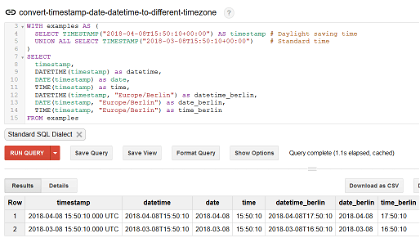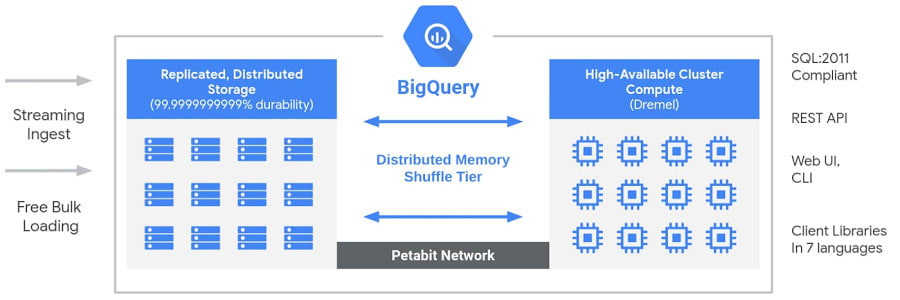Division By Zero Bigquery
Explanation of Division by Zero in BigQuery:
Division by zero occurs when any expression attempts to divide a number by zero. In BigQuery, similar to other database management systems (DBMS), division by zero results in a runtime error. The error message usually indicates a “Division by zero error encountered” or similar. BigQuery adheres to mathematical conventions by not allowing division by zero, as it leads to undefined results.
Behavior of Division by Zero in BigQuery:
When a division by zero error is encountered in BigQuery, the system generates an error message and terminates the query’s execution. This behavior ensures the integrity of the calculations performed in BigQuery and prevents misleading or inaccurate results. It is crucial to address division by zero errors to maintain the quality and reliability of data analysis.
Handling Division by Zero Errors in BigQuery:
To handle division by zero errors in BigQuery, it is essential to anticipate and prevent these errors through careful query design. There are several ways to approach this issue:
1. Conditional statements: Incorporate conditional statements to check for zero denominators before dividing. This ensures that division is only executed if the divisor is not zero. For instance, you can use the IF statement or the CASE statement to include logical checks before performing a division.
2. Using NULLIF function: BigQuery provides the NULLIF function, which allows you to replace division by zero with NULL. This function takes two arguments and returns NULL if both arguments are equal. By using NULLIF, you can bypass the division by zero error and handle it gracefully. However, it’s important to handle NULL values appropriately in subsequent calculations.
Impact of Division by Zero Errors in BigQuery:
Division by zero errors in BigQuery can have significant impacts on data analysis. These errors can lead to inaccurate calculations, misleading visualizations, and erroneous insights. Additionally, if division by zero errors are not handled properly, they can propagate through subsequent calculations, potentially amplifying inaccuracies or even causing cascading errors.
Best Practices to Avoid Division by Zero Errors in BigQuery:
Preventing division by zero errors from occurring in the first place is the best approach. Here are some best practices to avoid division by zero errors in BigQuery:
1. Data validation: Validate input data to ensure that divisor columns or variables do not contain zero values before executing calculations involving division.
2. Filtering zero denominators: Use filters or WHERE clauses to exclude rows where the denominator is zero, reducing the chance of encountering division by zero.
3. Default values: Assign a suitable default value or fallback value to substitute for division by zero results. This could be NULL, zero, or any other appropriate substitute based on your specific analysis requirements.
4. Utilizing aggregation functions: When performing calculations with division, use appropriate aggregation functions like SUM, COUNT, AVG, etc., which handle division by zero automatically and produce sensible results.
Conclusion:
Division by zero errors in BigQuery can have significant consequences for data analysis, leading to inaccurate insights and misleading interpretations. By understanding the behavior of division by zero errors and following best practices to avoid them, data analysts and developers can ensure the integrity and accuracy of their calculations. Remember to employ conditional statements, use the NULLIF function, validate data, filter zero denominators, and utilize appropriate aggregation functions to handle division by zero errors effectively in BigQuery. By adhering to these best practices, the quality of data analysis in BigQuery can be enhanced, yielding more reliable and trustworthy results.
FAQs:
Q: What happens when division by zero occurs in BigQuery?
A: When division by zero occurs in BigQuery, a runtime error is generated, terminating the query’s execution. This behavior ensures the integrity of calculations and prevents inaccurate or misleading results.
Q: How can division by zero errors be handled in BigQuery?
A: Division by zero errors in BigQuery can be handled by incorporating conditional statements, using the NULLIF function, validating data, filtering zero denominators, and utilizing appropriate aggregation functions.
Q: What are the impacts of division by zero errors in BigQuery?
A: Division by zero errors in BigQuery can result in inaccurate calculations, misleading visualizations, and erroneous insights. If not handled correctly, these errors can propagate through subsequent calculations, potentially causing cascading errors.
Q: What are the best practices to avoid division by zero errors in BigQuery?
A: Some best practices to avoid division by zero errors in BigQuery include data validation, filtering zero denominators, assigning default values, and utilizing appropriate aggregation functions.
Q: How can conditional statements be used to handle division by zero errors in BigQuery?
A: Conditional statements like the IF statement or the CASE statement can be used to check for zero denominators before performing division in BigQuery. This ensures that division is only executed when the divisor is not zero.
Sql : Bigquery Throws \”Division By Zero: 0 / 0\” Error
Keywords searched by users: division by zero bigquery SQL divide by zero, Divide by zero error encountered
Categories: Top 74 Division By Zero Bigquery
See more here: nhanvietluanvan.com
Sql Divide By Zero
Structured Query Language (SQL) is a programming language used for managing and manipulating relational databases. It provides us with powerful capabilities to retrieve, update, and manipulate data. However, when it comes to dividing by zero, SQL presents a unique challenge. In this article, we will delve into the intricacies of SQL divide by zero, its causes, consequences, and most importantly, the solutions.
Understanding SQL Divide By Zero
In mathematical terms, dividing any number by zero is undefined, as it contradicts the fundamental principles of arithmetic. SQL follows the same fundamental principles, and any attempt to divide a numerical value by zero reflects an error in the code.
Causes of SQL Divide By Zero
There are various scenarios where SQL divide by zero errors can occur. Here are a few common causes:
1. Human Input: The most common cause of divide by zero errors is when the programmer or the end-user mistakenly provides a zero as a divisor.
2. Aggregation Functions: Aggregate functions (e.g., SUM, AVG) are prone to divide by zero errors, especially when a divisor relies on a column that may contain zero values. For instance, calculating the average of a set of values containing zeros can lead to a divide by zero situation.
3. Complex Queries: Complex queries with multiple joins, subqueries, or nested calculations can inadvertently lead to divide by zero errors if proper precautions are not taken.
Consequences of SQL Divide By Zero Errors
When an SQL divide by zero error occurs, it can have cascading effects on the program or application utilizing the database. Here are some consequences of such errors:
1. Query Failures: The query where the divide by zero error occurs will fail, potentially impacting other dependent queries and operations.
2. Application Instability: If the failed query is part of an application, it can lead to application instability, causing crashes or unexpected behavior, affecting the end-users’ experience.
3. Data Inconsistency: If the failed query involves updating or inserting data, it can result in data inconsistencies within the database, compromising the integrity of the data.
Solutions to SQL Divide By Zero
To tackle SQL divide by zero errors, it is essential to adopt preventive measures and implement suitable handling mechanisms. Here are a few solutions to mitigate these errors:
1. Conditional Statements: Incorporate conditional statements to handle divide by zero errors before executing the division operation. You can use the CASE statement or IF-ELSE constructs in your SQL code to check if the divisor is zero before performing the division operation.
2. NULLIF Function: Utilize the NULLIF function to set the divisor to NULL if it is zero. This function replaces the zero value with NULL, allowing the division operation to proceed without triggering an error. The result will also be NULL if the divisor is zero.
3. Data Validation: Ensure that the data entered into the database is validated correctly. Implement validation checks to prevent zero values from being entered as divisors, and provide appropriate error messages to guide the user in rectifying the input.
4. Handling Aggregate Functions: When using aggregate functions, take caution and filter out zero values or NULL values if necessary, to avoid triggering divide by zero errors. You can use WHERE clauses or appropriate filters to exclude such values from calculations.
5. Error Handling and Logging: Implement robust error handling mechanisms to catch and handle divide by zero errors gracefully. Logging these error occurrences can help maintain a record and facilitate troubleshooting.
Frequently Asked Questions (FAQs):
Q: What happens when you divide by zero in SQL?
A: Dividing by zero in SQL leads to a divide by zero error. SQL follows the mathematical principle of undefined division by zero, resulting in an error that halts query execution.
Q: How can I prevent divide by zero errors in SQL?
A: To prevent divide by zero errors, incorporate conditional statements and validation checks in your SQL code. Use the NULLIF function to handle zero divisors. Additionally, filter out zero values or NULL values when using aggregate functions.
Q: What are the consequences of SQL divide by zero errors?
A: SQL divide by zero errors can lead to query failures, application instability, and data inconsistencies within the database. They can impact dependent queries, cause crashes, unexpected behaviors, and compromise data integrity.
Q: Can I divide by zero using a CASE statement?
A: Yes, you can use a CASE statement in SQL to handle divide by zero scenarios. By evaluating the divisor using a CASE condition and providing alternate values or handling mechanisms, you can prevent the divide by zero error.
Q: Is there a performance impact when handling divide by zero errors in SQL?
A: Implementing proper handling mechanisms for divide by zero errors in SQL might introduce a slight performance impact due to the additional evaluations and conditions. However, this impact is negligible compared to the potential consequences of unhandled errors.
In conclusion, SQL divide by zero errors can have severe consequences on database operations and applications. By employing preventive measures like conditional statements, data validation, and handling mechanisms, developers can ensure the smooth execution of their SQL code, minimizing the risk of divide by zero errors and their consequences.
Divide By Zero Error Encountered
When it comes to mathematical operations, dividing any number by zero may seem like an innocent task. However, in the world of computing, this seemingly simple action can quickly turn into a problematic error known as the “divide by zero error.” This article aims to explore the intricacies of this error, especially within the English language, a fundamental component of computational systems. So, let’s delve into this puzzling predicament and understand why dividing by zero causes such trouble.
The concept of division holds a crucial place in mathematical operations. It allows us to distribute quantities evenly and provides a framework to understand ratios, proportions, and many other fundamental calculations. However, division by zero defies the foundations of mathematics and poses a dilemma for computers programmed to follow these principles.
Within the realm of English, divide by zero errors primarily occur during linguistic tasks that involve incorrect calculations or assumptions. Let’s consider an example sentence: “If each member of the team shares the workload equally, but one team member is missing, how much work does each person now need to do?” If we were to naively divide the workload by zero, we would encounter a divide by zero error, as it is impossible to divide any quantity equally among zero individuals.
These linguistic scenarios often arise due to logical pitfalls, such as assuming the presence of an entity when it is absent or making impossible comparisons. As computers rely on precise instructions, they struggle to handle these illogical calculations, leading to errors known as “exceptions” in programming.
Frequently Asked Questions (FAQs):
Q: How does a divide by zero error occur in English?
A: A divide by zero error in English occurs when an illogical calculation or assumption leads to an attempt to divide a quantity by zero.
Q: Are divide by zero errors solely limited to computing?
A: No, divide by zero errors extend beyond computing. They can occur in various fields where mathematical concepts are applied, such as physics or engineering, where dividing by zero might lead to undefined results.
Q: What happens when you divide a number by zero?
A: In mathematics, dividing any number by zero is considered undefined. It defies the fundamental principles of division, leading to an error.
Q: Can we find a solution to divide by zero errors?
A: Strictly speaking, dividing by zero is mathematically impossible. However, in computing, programs can be designed to detect divide by zero scenarios and handle them gracefully to avoid crashing or producing incorrect results.
Q: Does the divide by zero error affect all programming languages?
A: Yes, divide by zero errors are a universal problem across programming languages. However, different languages may handle these errors differently, providing varying levels of error messages or exceptions.
Q: How can divide by zero errors be prevented in programming?
A: One effective way to mitigate divide by zero errors is by implementing appropriate checks and conditionals before executing division operations. These checks can ensure that the divisor is never zero, preventing such errors from occurring.
In the realm of computing, dividing by zero serves as an instructive reminder of the importance of following mathematical principles. While division by zero may appear straightforward when working with numbers, the English language introduces complexities where divide by zero errors can occur through illogical assumptions and calculations. These errors are not limited to computing but extend to other fields where mathematical concepts are applied.
Understanding and addressing the divide by zero error is essential to developing robust computational systems, especially in the English language. By implementing checks and conditionals within programs, developers can mitigate the chances of encountering divide by zero errors. Nonetheless, it is crucial to acknowledge the underlying mathematical impossibility of dividing any quantity by zero to ensure accurate computations and results within the realm of English and beyond.
Images related to the topic division by zero bigquery

Found 13 images related to division by zero bigquery theme












.webp)




Article link: division by zero bigquery.
Learn more about the topic division by zero bigquery.
- bigQuery throws “division by zero: 0 / 0” error – Stack Overflow
- 3 ways to divide safely in BigQuery | by Khristina Rustanovich
- Mathematical functions | BigQuery – Google Cloud
- HELP TO BEAT ‘DIVISION BY ZERO’ ERROR – ROUND() Syntax
- How to Handle Divide by Zero In SQL – LearnSQL.com
- Divide by zero error – job_execution.sql · Issue #227 – GitHub
- IEEE_DIVIDE function in Bigquery – SQL Syntax and Examples
- Google BigQuery Data types – An Ultimate Guide – Boltic
- How to calculate a percentage of total in BigQuery using SQL
- User swm – Meta Stack Exchange
See more: https://nhanvietluanvan.com/luat-hoc